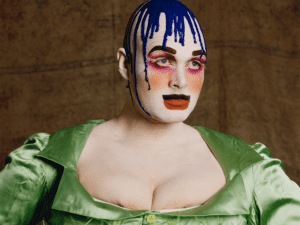In an ever-expanding artistic landscape, championing new voices becomes increasingly important. Now in its 12th year, The Foam Paul Huf Award celebrates emerging talent within the photographic realm. Awarded to international practitioners under 35, prizes comprise €20,000 and an exhibition at Foam, Amsterdam. Previous winners approach contemporary social concerns through a diverse array of methods, expanding the boundaries of the medium whilst foregrounding the shared human experience.
2017: Romain Mader
Mader’s (b. 1988) winning series Ekaterina depicts a search for a bride in an imaginary town. Investigating the intersection between fantasy and reality; love and exploitation, the photographer often interrupts fictional scenes with comical self-portraits, “photo-bombing” idyllic, brightly lit set-ups. Mader explores the symbolism surrounding relationships by performing various associated rituals.
2016: Daisuke Yokota
Yokota (b. 1983) works experimentally, using chemical and digital processes to create distorted, abstract images. The New Colour series questions the limits of sight, presenting the capabilities of reprocessing through duplicates. The artist disrupts the usual development process by adding boiling water and combining the various layers, creating a multifaceted surface of texture and exposed, spectrum-like studies.
2015: Momo Okabe
Focusing on the private realm of personal relationships, intense emotions and altering sexualities, the hyperreal scenarios captured by Okabe (b. 1981) consolidate in two series. By exploring otherwise concealed elements alive within contemporary Japanese society, the images depict individuals in vulnerable states, commenting on the human form and notions of binaries.
2014: Daniel Gordon
Blurring the boundaries between photography, pop-art painting and paper sculpture, Gordon’s (b. 1980) vivid use of primary colours is paired with a DIY collage style. A refreshed look at still life, his collection invites viewers to focus on the composition, whilst simultaneously generating a desire to pick apart and distinguish individual elements which are hidden under a sea of pattern.
2013: Taiyo Onorato & Nico Krebs
The artists’ collaborative practice constructs sculptural compositions that pair a meticulous eye for detail with subtle undertones of humour. The Great Unreal takes the American road trip as its starting point, exposing the fictional symbolism and mythic aura surrounding the journey’s popularity.
2012: Alex Prager
Prager (b. 1979)’s cinematic aesthetic examines notions of the gaze, investigating themes of voyeurism by placing the viewer at surprising perspectives. Blurring the boundaries between artificiality and reality, the pieces reveal the inauthenticity of the everyday. The artist also works in film, foregrounding the synchronisation between music and visuals.
2011: Raphaël Dallaporta
Addressing human rights and ethical concerns, Dallaporta (b. 1980) operates closely with specialists in topical fields that relate to his projects. These include a landmine clearer for Antipersonnel, archaeologists for Ruins and a forensic pathologist for Fragile. The practitioner stages individual objects against a stark, black background, emphasising compositional brutality and looking towards wider narratives.
2010: Alexander Gronsky
In parts of Russia, the population is less than one per 100km. Gronsky’s (b. 1980) practice focuses on isolation and solitude in such regions. Series such as Less Than One and The Edge are taken during winter, creating dialogues between concrete Soviet architecture, suburban inhabitants and a dominating white backdrop.
2009: Léonie Hampton
Hampton (b. 1978) explores personal experiences in dialogue with universal concerns, offering intimate family snapshots alongside snippets of sound. A subsequent book, In the Shadow of Things, charts Hampton’s mother’s OCD and its impact on everyday life, whilst the latest series, Mend, for the XV Rome Commission, tackles environmental and social problems.
2008: Pieter Hugo
An interest in African culture and tradition drives Hugo’s (b. 1976) direct and unsettling style of portraiture. A recent exhibition at the Kunstmuseum Wolfsburg, Between The Devil and The Deep Blue Sea, posed questions about cultural repression and political dominance, taking a non-hierarchical approach to capturing subcultures and social realities in South Africa, Rwanda, Nigeria, Ghana, and China.
2007: Mikhael Subotzky and Taryn Simon
Subotzky (b. 1981) body of work takes a documentary approach, unearth the social and physical activities that occur within prisons. The images uncover the relationship between violence and vulnerability within all-male environments, examining notions of identity in institutions. Simon’s (b. 1975) multidisciplinary oeuvre is extensively researched. Series such as A Living Man Declared Dead and Other Chapters I – XVIII explore notions of territories and bloodlines, whilst the most recent project, An Occupation of Loss examines the grieving process,
The winner of the 2018 award is announced 8 March. Find out more here.
Credits:
1. Alex Prager, Crowd #7 (Bob Hope Airport), 2013. From Face in The Crowd.
2. Alexander Gronsky, from The Edge.
3. Taiyo Onorato & Nico Krebs, Abbyss, 2006, from The Great Unreal.




